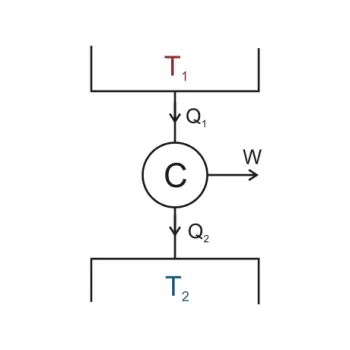
The second law of thermodynamics states: "The amount of entropy in the universe tends to increase with time."
It follows from the second principle that while all work can be converted into heat. However, not all heat can be converted into work. The maximum efficiency that can be achieved is the Carnot efficiency.
According to Rudolf Clausius, “Heat can never pass from a colder to a warmer body without some other change, connected in addition to that, occurring at the same time.”. It is known as the Clausius statement.
According to the first law, every thermodynamic process in a given system must satisfy the principle of conservation of energy.
The equation: ![]()
It establishes that any process whose sole purpose is to create or destroy energy is impossible. At the same time, it denies the existence of a first-class perpetual motion machine.
The first principle of thermodynamics states that energy cannot be created or destroyed. however, it tells us nothing about the direction in which a process can occur in a system. Therefore, it assumes that all processes are reversible processes.
Entropy and the second principle of thermodynamics
At the second law of thermodynamics appears a new important concept; it is called entropy.
The second law requires that generally speaking, any system’s total entropy cannot decrease more than increasing some other system’s entropy.
An irreversible process increases the entropy of the universe. The second law of thermodynamics can be used to determine whether a process is reversible or not.
Therefore, in an isolated system from its surroundings, the entropy of that system tends not to decrease. For this reason, heat cannot flow from a cold object to a hot object without adding work (the imposition of order) to the colder body. It would violate the second law of thermodynamics.
The applicability of the second law of thermodynamics is limited to closed systems that are near or in a state of thermal equilibrium.
Examples of the second law of thermodynamics
This restriction in the direction manifests itself in all spontaneous or natural processes. Indeed, we always observe some examples forms of the second law:
-
A compressed gas tends to expand.
-
Heat transfer always happens from hot to cold bodies.
-
The operation of an air conditioner. Cooling the air reduces the entropy of the air in that system.
We never observe that these processes occur spontaneously in the opposite direction. In no case does heat flow from a cold body to a hot one without external work.
Thermal machines
In theory, a perfectly efficient heat engine should convert all absorbed heat energy into mechanical work. The second law of thermodynamics states that this is impossible.
A heat engine aims to provide work continuously to the outside from absorbed heat.
If we imagine a cycle carried out in the opposite direction to that of a motor, the final result will be:
-
Low-temperature heat absorption.
-
Ejection of a larger quantity at a higher temperature
-
And finally, the realization of a net amount of work on the system.


